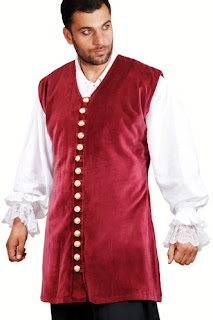* Materials and fabrics – Medieval costumes of royal and wealthier people were made from the fabrics of silk, satin, taffeta, sarcanet, scarlet and velvet. Scarlet a plain fabric and sarcanet was a form of delicate silk. If colors that give lustrous and rich shades to fabric weren’t available in the region then they were imported at great expense from Middle East countries. Most commonly worn clothes were of silk, satin, tinseled, and silver. They were made from blended fabric or pure fabric with engraved embroideries. Only upper class people were allowed to wear medieval clothing of rich fabric. Commoners were only allowed to use cotton, sheepskin and linen as fabric and black or grey color.
Slashing technique – Limiting fabric and color of costume to a particular section of society lead to the creation of new technique called slashing. This technique was a way of answering to rule makers who imposed restriction over the use of bright colors and luxuriant fabric on lower strata people. A cut was made on the outer surface of cloth from which inner lining popped out and creates a contracting effect. One more method was developed called ‘Pink’ in this method fabric was cut into diamond shape through which inner lining appeared. Picking was more delicate than clashing.
Geometric Shape – Rather than designing dress in natural shape of body, royal ladies chose to go for geometric shape. In order to get desired shape fabrics were quilted or padded and for stiffing, whalebone or buckram was used. To get flat triangular shape corsets were worn under the gown. Wearing medieval dress was difficult process for royal ladies and need atleast two helpers to fit into them but all was endure for the sake of fashion and beauty.
Exquisite Sleeves – Sleeves were the most elaborate part of the medieval costumes. Designed with very fine details they were available in various styles, even in padded form too. Sleeves were separately sewed and attached to main outfit by tying or pinning. Padded wings on shoulder hide the joins of sleeves. Ruffs were added part of collar and sometime around cuffs also.
Tudor style of dressing had great degree of impact on renaissance costumes during later periods. Long voluminous dresses with funnel shaped sleeves and same old rule on clothing were derived from Tudor period. But the situation was not same for pirates. Pirate clothing was became more flamboyant and many new addition were introduced.
Medieval clothing of Tudor period and renaissance costume were almost had same approach in terms of fabrics and patterns with little changes designs.

 Renaissance clothing flourished in the middle of the medieval age. In theta period, people who were affluent and rich wore this kind of clothing. Costumes were woven from hands and were quite exquisite. The fabrics used for medieval costumes were expensive and luxurious. During that period clothing determined the social stature of the person.
Renaissance clothing flourished in the middle of the medieval age. In theta period, people who were affluent and rich wore this kind of clothing. Costumes were woven from hands and were quite exquisite. The fabrics used for medieval costumes were expensive and luxurious. During that period clothing determined the social stature of the person. 
 Renaissance costume had some really interesting designs for both men and women; the designs were more of lavish as well as sophisticated. Furs and silks were mainly used as it depicted luxury and status. It was kind of showing of one’s social status through means of clothing. It is generally believed that fashion came into existence with the era and nothing like style or trend was seen before this. Initially these renaissance clothes restricted the movement but later it changed eventually. Layers were generally preferred and women costumes included skirt, vest, bodice, collar and an underskirt. Men’s wear consisted of coats and clothes that gave a square look to man’s body. Lots of padding was done to make the shoulder broader. They also wore long tunics which went down to the knees. Men’s fashion focused on material that had a bold look, long sleeves were preferred, tight body garments, brimmed caps and leather jackets.
Renaissance costume had some really interesting designs for both men and women; the designs were more of lavish as well as sophisticated. Furs and silks were mainly used as it depicted luxury and status. It was kind of showing of one’s social status through means of clothing. It is generally believed that fashion came into existence with the era and nothing like style or trend was seen before this. Initially these renaissance clothes restricted the movement but later it changed eventually. Layers were generally preferred and women costumes included skirt, vest, bodice, collar and an underskirt. Men’s wear consisted of coats and clothes that gave a square look to man’s body. Lots of padding was done to make the shoulder broader. They also wore long tunics which went down to the knees. Men’s fashion focused on material that had a bold look, long sleeves were preferred, tight body garments, brimmed caps and leather jackets.